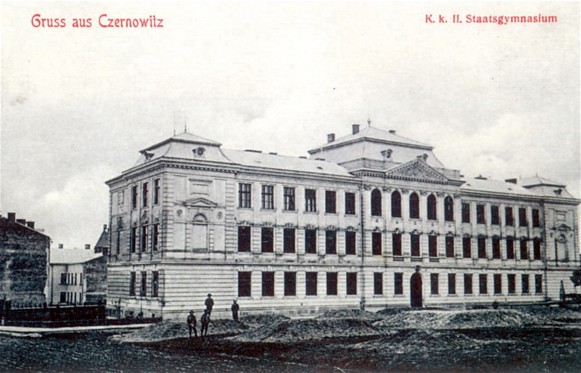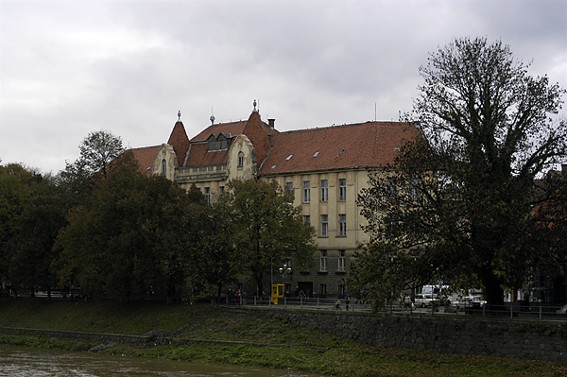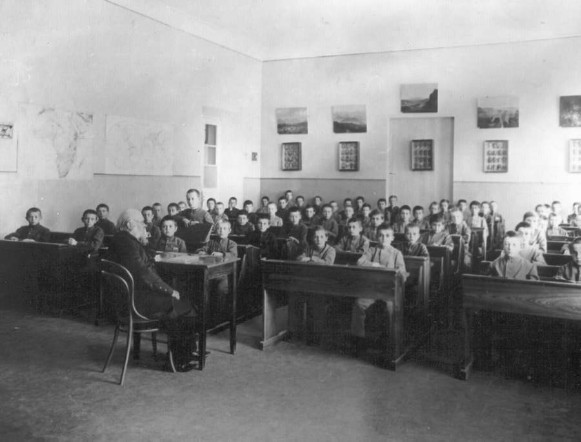Gymnasium
Gymnasium [гімназія; himnaziia]. A general-education secondary school preparing students for university. Gymnasiums originated in Germany in the 16th century.
Galicia. Under the Polish Commonwealth, education in Ukraine was parochial (see Parochial schools); the brotherhood schools and later the Basilian monastic order administered elementary (see Elementary schools) and secondary education for Ukrainians, while the Jesuits were primarily responsible for educating Roman Catholics. Austria's recognition of the equality of the Greek Catholic church and Roman Catholic church in the territories acquired by it from Poland in 1772 led to important educational reforms. With the dissolution of the Jesuit order in 1773, its schools in Galicia were replaced by state schools, including four gymnasiums. Most of the students were children of Polish nobles or of German or Czech officials. In 1784, however, Joseph II decreed that only gymnasium graduates would be admitted to seminaries and established Lviv University and the Academic Gymnasium of Lviv for training Greek Catholic priests with a command of Ukrainian (Ruthenian). The medium of instruction was Latin, with German as an auxiliary language. Ukrainian was taught as a subject. In 1818 the curriculum was expanded from five to six grades; two more grades were added in 1849.
In 1849 the Supreme Ruthenian Council demanded that Ukrainian be introduced as the language of instruction in state schools located in predominantly Ukrainian areas of Galicia. While accepting the demand in principle, the central authorities postponed its implementation out of practical considerations and made Ukrainian a compulsory subject. It retained this status until 1856.
Under the constitution of 1867, the Poles gained control of Galicia's provincial government and educational system. State-funded schools, which had been overseen from 1848 by the imperial Ministry of Education and from 1855 by the consistories (see Consistory), were placed under the Provincial School Board. In the gymnasiums Polish replaced German as the language of instruction. Ukrainian was admitted only as a ‘conditionally compulsory’ subject (one's choice could not be changed later). Ukrainian was allowed as the medium of instruction only at the Academic Gymnasium of Lviv, at first only in the four lower grades; in the upper grades Polish was used until 1874. State funding for new classes or schools was granted by the Polish-dominated Galician Diet; hence Ukrainian gymnasiums and even parallel Ukrainian classes at Polish gymnasiums could not be established without a determined political struggle. By 1910 there were 35 state gymnasiums in eastern Galicia: 28 Polish, 5 (and a branch) Ukrainian, and 1 German. Thus, there was one Polish gymnasium per 60,400 Poles and one Ukrainian gymnasium per 666,000 Ukrainians. Ukrainian was the language of instruction at the following state gymnasiums: the Academic Gymnasium of Lviv and its branch (est 1906), the Peremyshl State Gymnasium (parallel Ukrainian courses from 1888, an independent school from 1895), and the Kolomyia (parallel courses from 1893, independent from 1900), Ternopil (parallel courses from 1898, independent from 1906), and Stanyslaviv (1905) gymnasiums. Parallel Ukrainian classes were also established in the Polish gymnasiums in Berezhany (1906) and Stryi (1907).
Their access to public funding blocked by Polish authorities, Ukrainians turned to organizing privately funded schools. Most of the private Ukrainian gymnasiums were sponsored by the Ruthenian (from 1912 Ukrainian) Pedagogical Society (see Ridna Shkola society) and the Provincial School Union. By 1914 the following towns had private gymnasiums: Kopychyntsi (1908), Yavoriv (1908), Buchach (1908), Horodenka (1909), Rohatyn (1909), Brody (1909), Peremyshliany (1909), Zbarazh (1910), Busk (1910), Dolyna (1911), and Chortkiv (1911). For girls there were two secondary schools: a lyceum of the Ukrainian Girls' Institute in Peremyshl (1903) and the first Ukrainian gymnasium for girls run by the Basilian order of nuns in Lviv (1906). It was difficult to obtain accreditation for these schools from the Provincial School Board, which was controlled by the Poles. Unaccredited gymnasiums could not issue diplomas and could not apply for state support. While many private Polish gymnasiums were accepted after one or two years into the state school system, private Ukrainian schools were not and remained a heavy drain on the financial resources of the Ukrainian community. From 1908 to 1911, Ukrainian boys in Galician gymnasiums numbered 5,670–7,230, or approximately 21–23 percent of the total enrollment in all boys' gymnasiums. Meanwhile, the greater importance of private education is evidenced by the fact that in 1911–12 Ukrainian boys accounted for 33 percent of the enrollment in private gymnasiums; the respective figure for girls was approximately 8 percent. At the time Ukrainians accounted for 42 percent of the province's population.
All Ukrainian gymnasiums were of the classical type, emphasizing Latin and Greek. Their curriculum consisted of the following compulsory subjects: religion, Latin, the language of instruction (Ukrainian or Polish), world geography and history, mathematics (all taught from grades one to eight), Greek (from grade three to eight), biology (grades one, two, five, and six), and physics (grades three, four, seven, and eight). German, French, music, art, physical education, history of Austria-Hungary, stenography, and the other provincial language (Polish or Ukrainian) were electives. Few Ukrainians attended so-called realgymnasiums, which emphasized modern languages and science, or technical schools, partly because these were Polish and partly because technical education was not held in high esteem.
Ukrainian gymnasiums were closed down during the Russian occupation of Galicia (1914–17). In February 1919 the government of the Western Ukrainian National Republic nationalized some private Ukrainian gymnasiums and Ukrainianized some Polish state gymnasiums in Galicia. Thus, the number of Ukrainian state gymnasiums rose to 20. Upon conquering Galicia the Polish authorities recognized only the seven Ukrainian state gymnasiums that had existed before 1 November 1918. In 1920 the gymnasium system was reformed and the humanistic gymnasium (without the Greek language) was introduced. The Ukrainian state gymnasiums were all classical ones, but some new private gymnasiums were humanistic. By 1923 there were 14 Ukrainian gymnasiums financed by the Ukrainian Pedagogical Society (renamed Ridna Shkola society in 1926) and parallel Ukrainian classes at the Polish gymnasium in Stryi. In Volhynia, annexed by Poland in 1919, there were only three coeducational private Ukrainian gymnasiums: in Lutsk (1918), Kremenets (1923), and Rivne (1923). From 1924 instruction in history, geography, and Polish civics at Ukrainian gymnasiums had to be given by Polish teachers. Later some military training became compulsory as well. Ukrainian was taught to all boys at some Polish gymnasiums because of its possible usefulness in war against the USSR. In 1932 extensive gymnasium reforms were introduced: grades three to six of the old gymnasium were turned into a new four-year gymnasium, while grades seven and eight became a two-grade lyceum. By curriculum the gymnasiums were classified into mathematico-physical, naturalistic, humanistic, classical, and other categories. By 1939 the number of Ukrainian state gymnasiums declined to 5, while the number of private gymnasiums increased to 22. Of the 27 gymnasiums, 13 were coeducational, 7 were for boys, and 7 for girls. There were also 5 state-funded and 16 private Ukrainian lyceums. At the same time there were 114 Polish gymnasiums and 106 lyceums in Galicia. The total enrollment in Ukrainian gymnasiums and lyceums was 6,000.
During the Second World War the Generalgouvernement Ukrainian gymnasiums were established in Jarosław and Kholm. With the incorporation of Galicia into the Generalgouvernement in 1941, ten more Ukrainian gymnasiums were established. By 1942 enrollment at the 12 gymnasiums reached 7,017 students, including 2,137 girls; enrollments fell to 5,700 in the following years because of restrictions imposed by German authorities. After the second Soviet occupation of Galicia in 1944, gymnasiums were replaced with ten-year schools. The gymnasiums in Jarosław and Kholm, which became part of Poland, were closed down by the authorities.
Transcarpathia. The first gymnasium in Transcarpathia was established at Uzhhorod as the Royal Archgymnasium (later Uzhhorod gymnasium) in 1778. In 1790 Latin replaced German as the language of instruction, and in 1796 Hungarian replaced Latin. The limited use of Ukrainian was permitted from 1849 to 1851 as a reward to the Ukrainians for their loyalty during the Hungarian revolution. Ukrainian was an optional subject at the Hungarian gymnasiums in Mukachevo (est 1872) and Berehove. With the incorporation of Transcarpathia into Czechoslovakia in 1919, the gymnasiums were transformed into realgymnasiums and Ukrainian was introduced as a language of instruction. By 1921–2 a fourth Ukrainian gymnasium had opened in Khust, and in 1922–3 Ukrainian students numbered 1,660. In 1936 a Ukrainian classical gymnasium was founded by the Basilian monastic order in Uzhhrod. By 1938 Subcarpathian Ruthenia had five Ukrainian (three of which offered parallel courses in Czech or Magyar), one Czech, and two Hebrew gymnasiums. In the autonomous state of Carpatho-Ukraine (October 1938–March 1939) there was one private and seven state-funded Ukrainian gymnasiums with an enrollment of 1,941 boys and 1,193 girls. Under the Hungarian occupation (1939–44) all but three Ukrainian gymnasiums were Magyarized; only the local dialect was permitted in the schools, and the term ‘Ukrainian’ was banned. In 1945 the Soviet school system was introduced and ten-year schools replaced gymnasiums. In the Prešov region there were three Ruthenian-Russian gymnasiums in 1945–6. Later they were transformed into Ukrainian secondary schools.
Bukovyna. The first gymnasium in Bukovyna was a German one opened in Chernivtsi in 1808. Ukrainian was offered as a subject at this school only from 1851. A second German gymnasium with parallel classes taught in Ukrainian was opened in Chernivtsi in 1896 (see Ukrainian Gymnasium in Chernivtsi), and a similar school was established in Kitsman in 1904. There were two Ukrainian schools: a classical state gymnasium in Vyzhnytsia (1908–21) and a private realgymnasium in Vashkivtsi (from 1912). The German gymnasium in Seret introduced parallel Ukrainian courses in 1914. On the eve of the Romanian invasion at the end of 1918 there were five Ukrainian gymnasiums (in Chernivtsi, Vyzhnytsia, Vashkivtsi, and two girls' gymnasiums in Chernivtsi and Kitsman) and three bilingual gymnasiums (in Chernivtsi, Kitsman, and Seret); their Ukrainian enrollment was 2,820. Under Romanian rule all gymnasiums in Bukovyna were Romanianized by 1924. When the region was incorporated into Soviet Ukraine, the gymnasiums were replaced by Soviet ten-year schools.
Russian-ruled Ukraine. The first gymnasiums appeared at the beginning of the 19th century in the larger cities: Poltava (1804), Kharkiv (1805), Chernihiv (1808), Novhorod-Siverskyi (1808), Kremenets (1812), Katerynoslav (1812), Kyiv (1812), Kherson (1814), and Vinnytsia (1814). Prior to that, higher education was provided mostly by the colleges. In time many county towns had gymnasiums. These schools were an important means of Russifying the offspring of the Cossack officer elite (see Cossack starshyna) and assimilating them to the Russian nobility. Besides the four-year classical gymnasiums, there were two commercial gymnasiums—in Odesa (1804–17) and Tahanrih (1806–37). After the Polish Insurrection of 1830–1, the Polish school system in Right-Bank Ukraine was dismantled and Russian gymnasiums were introduced. Responsibility for administering gymnasiums in Ukrainian territories was transferred from Kharkiv University and Vilnius University to school district curators (see School districts, Curator). In 1864 the gymnasiums were reorganized into classical (offering both Latin and Greek), semiclassical (offering Latin only), and realgymnasiums (offering no ancient languages). Furthermore, the progymnasium, corresponding to the first four years (and later six years) of a regular gymnasium, was introduced. The gymnasium curriculum consisted of religion, Russian language, French or German, mathematics (compulsory in all seven grades), Greek and history (grades three to seven), geography (grades one to four), natural history (grades one to three), and penmanship (grades one to four). Military gymnasiums established in 1862 were converted to cadet schools in 1882. Under the school statute of 1871, ancient languages were emphasized and science was removed from the curriculum. Grade seven was extended to two years, and admission of non-nobles was severely restricted. The realgymnasium was demoted to a Realschule, which prepared students for higher technical schools. Towards the end of the century the gymnasium curriculum diverged from the 1871 standard and admission requirements were eased considerably. The growth in the number of gymnasiums and progymnasiums and in their total enrollment is presented in Table 1.
At the beginning of the 20th century the number of gymnasiums, especially private ones, rose sharply. Most students were local Ukrainians with a strong admixture of Poles in Right-Bank Ukraine and, in the latter half of the 19th century, Jews in the south. This is illustrated in Table 3 by data on the religious composition of the student body in 1887.
Data on the social composition of the student body in 1887 show that gymnasiums basically educated young nobles and townsmen. Sons of clergy were encouraged to enter seminaries, not gymnasiums. (See Table 2.)
In 1862 private seven-year girls' gymnasiums began to be organized. The Ministry of Public Education began to set up similar gymnasiums in 1870. These schools did not offer ancient languages, but had seven regular grades and an eighth grade for training elementary-school teachers and governesses. Four- and five-grade state progymnasiums were also founded. There were many more private gymnasiums than state ones. By 1887 in the Kharkiv school district there were 18 girls' gymnasiums and 40 progymnasiums with a total enrollment of 10,337, while in the Odesa school district the respective figures were 17, 18, and 6,451. Before 1917 the gymnasiums in Ukraine were entirely Russian institutions. Only two private boys' gymnasiums—Volodymyr Naumenko's in Kyiv and Kovalchuk's in Odesa—encouraged an interest in Ukrainian culture. At the turn of the century secret Ukrainian student circles existed at gymnasiums in Kyiv, Poltava, Pryluky, and Lubny.
After the February Revolution of 1917 the Russian Provisional Government permitted the opening of only two Ukrainian gymnasiums. The efforts of the Secretariat of Education of the Ukrainian National Republic to Ukrainianize gymnasiums were hampered by Russified school administrators and teachers. The Ukrainian community, however, began to establish its own gymnasiums: the Shevchenko Gymnasium, the Cyril and Methodius Gymnasium, and three others in Kyiv; the Kotliarevsky Gymnasium in Poltava; the Hrinchenko Gymnasium in Kharkiv; the Drahomanov Gymnasium in Odesa; and others in Katerynoslav, Kamianets-Podilskyi, Kherson, and even in some county centers and larger villages. By the end of 1918 there were about 150 Ukrainian gymnasiums. The Ukrainian language and Ukrainian studies were taught at the established Russian gymnasiums in Ukraine. At the beginning of 1919 there were a total of 836 gymnasiums in the Ukrainian National Republic, of which 161 were state-funded, 409 community-funded, and 266 privately funded; 474 were for boys, 362 for girls. Two Ukrainian gymnasiums were established in the Kuban. In 1920, after the Bolsheviks occupied Ukraine, the gymnasiums were converted into labor schools (see Labor school).
Abroad. A number of Ukrainian gymnasiums were organized by Ukrainian émigrés; eg, in Harbin, Manchuria, in 1917 (closed down by Chinese authorities in the 1920s). After the war refugees and prisoners of war from the Ukrainian National Republic set up a gymnasium in Kalisz, Poland (1924–34) and a realgymnasium in Prague (1925, transferred to Řevnice in 1927 and to Modřany in 1937). After the Second World War 27 displaced persons camps in Germany and two in Austria had Ukrainian gymnasiums in 1947–8. As Ukrainians emigrated to countries with a different educational system, the Ukrainian gymnasium became all but extinct. One Ruthenian gymnasium, using the Bačka dialect as the medium of instruction, was established in 1945 in Ruski Krstur, Serbia.
(See also Education.)
BIBLIOGRAPHY
Buzek, J. Rozwój stanu szkół średnich w Galicyi w ciągu ostatnich lat 50 (1859–1909) (Lviv 1909)
Alston, P. Education and the State in Tsarist Russia (Stanford 1969)
Sirka, A. The Nationality Question in Austrian Education: The Case of Ukrainians in Galicia, 1867–1914 (Frankfurt am Main 1980)
Petro Polishchuk, Bohdan Struminsky
[This article originally appeared in the Encyclopedia of Ukraine, vol. 2 (1988).]


%20State_Gymnasium%20(postcard).jpg)

.jpg)